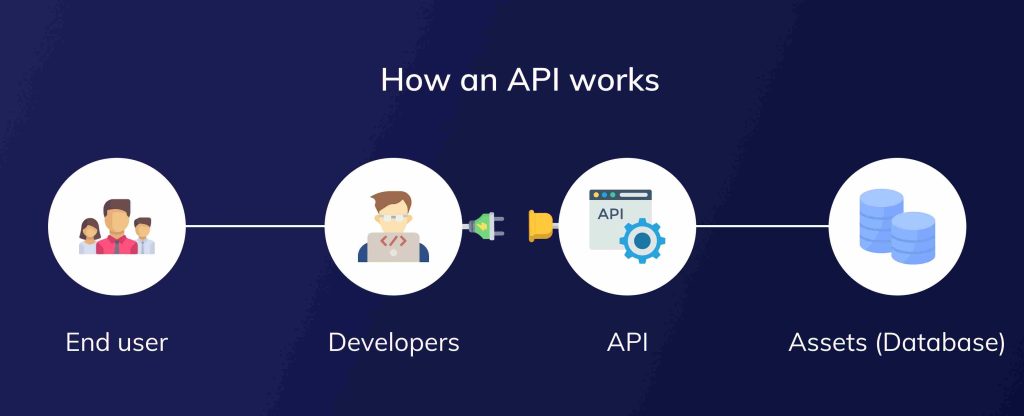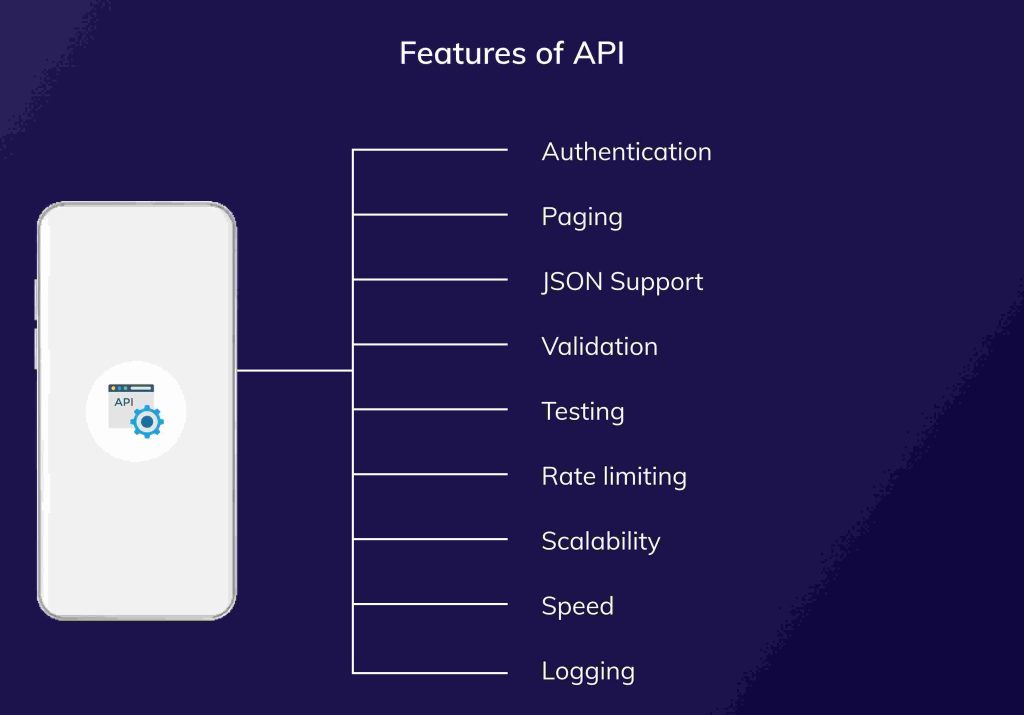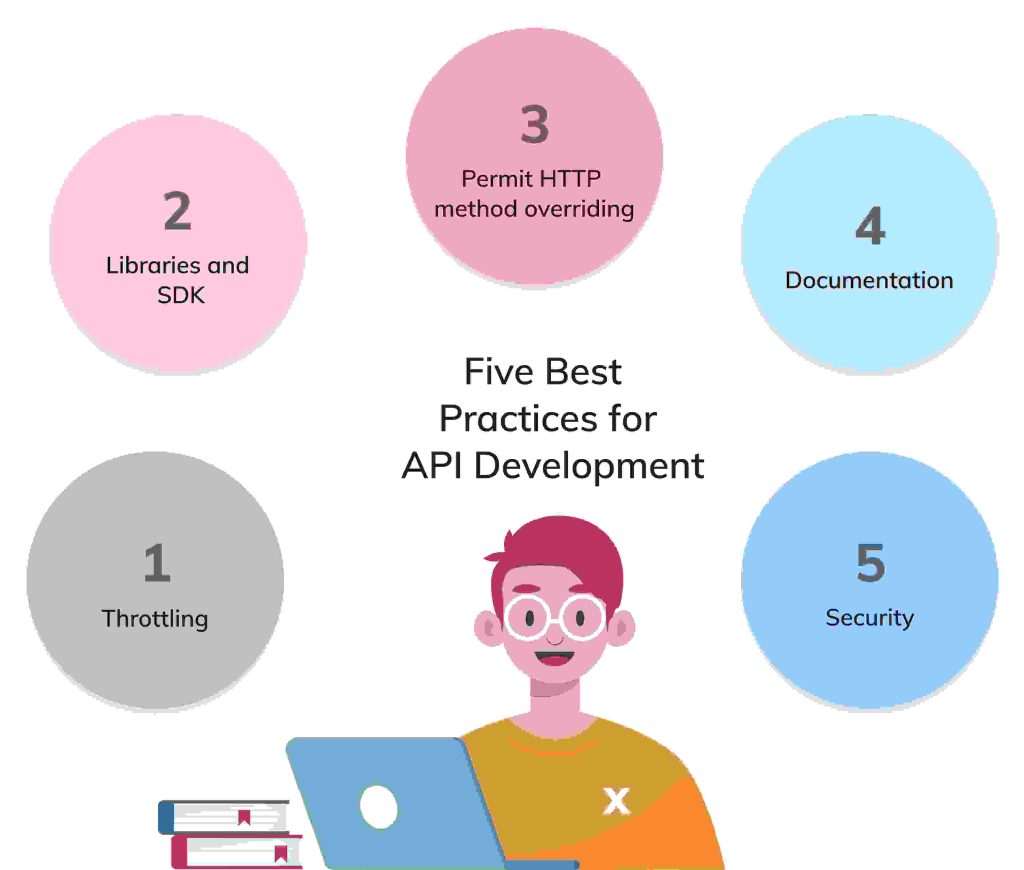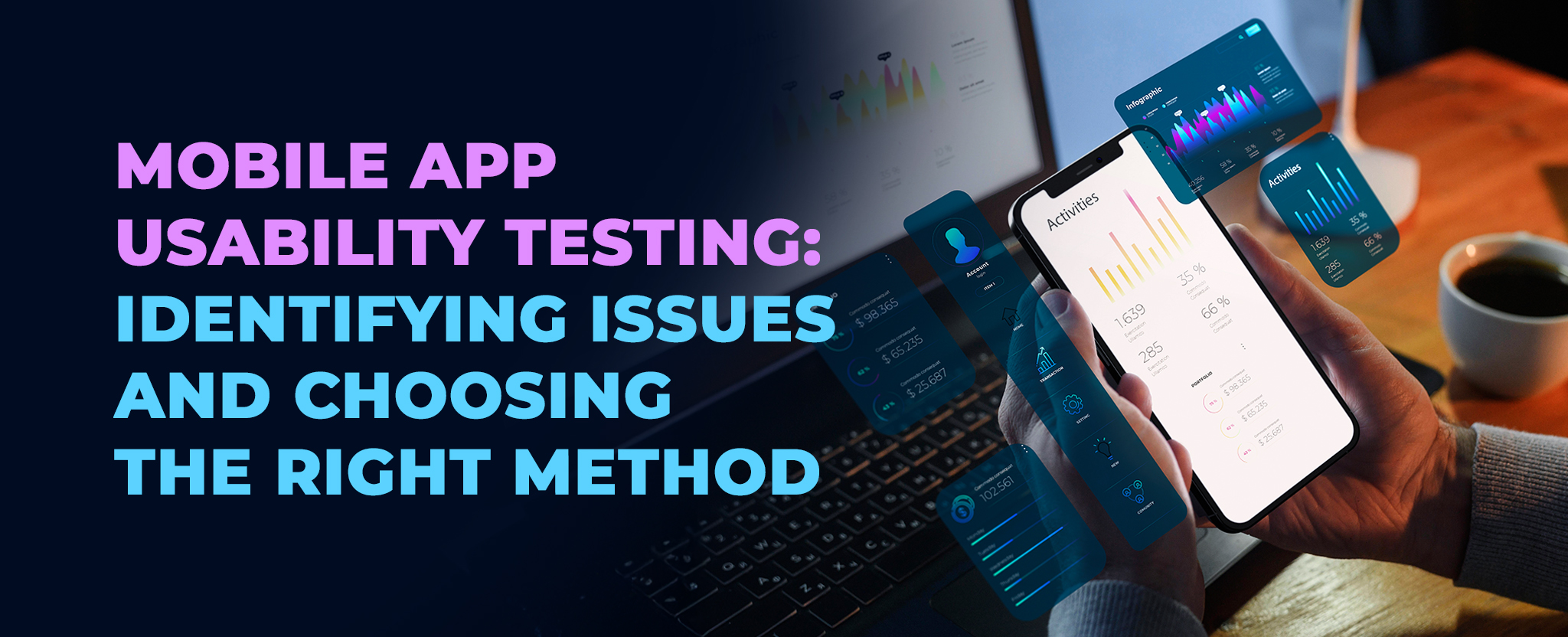An Absolute Guide to API Development
2 Jul 21 


Application Programming Interface or API- if you ever talked to app developers, chances are that you heard them praise it. The role of API in app development has grown far and wide today. Every app utilizes it. It has become the developers’ best friend. And in the current fastly transitioning development approach, API has essentially become a lifesaver.
If it ever got you wondering what an API is, you don’t have to look very far to find the answer. Mobile apps are important for businesses today, and as frequent mobile app users, you use API multiple times a day. For example, when you log in to your Facebook account, when you make payments using money transfer apps – it is the API that is working behind the scenes there. Seems interesting? Well then, read on. In this article, we will delve thoroughly into the world of API development.
What is API
In simple words, an API is a way for connecting different computer programs to communicate with each other. It allows the software to talk to each other, transmit, and exchange data. So, basically, an API is a set of programming codes or a software mediator. And how does it impact the process of creating a mobile app? By simplifying the development and making the process more flexible and rapid.
An API consists of a set of protocols, definitions, instructions and standards that will allow them to integrate with other applications. Each API will follow an API specification, that is, a standard that defines how the API will be built. The internal details of the API will be hidden, and only the interface will be disclosed. And who can access them? The programmer who works on incorporating it into the software.
In most applications where there is communication happening between two entities, API is utilized. It allows programmers to carry out development without necessarily having to go deep into the coding. Moreover, being able to reuse existing APIs to carry out similar functionalities eliminates the need for developing them from scratch, thereby saving much needed time and effort.
When Do You Need an API
Are you wondering if every software-based business must build APIs? Considering how it simplifies the connection between different applications, are you thinking if every business needs it? While it is indeed a popular mobile app development trend, let me tell you that you don’t necessarily have to build APIs for your business solutions. Although it has many benefits, it might not be feasible/appropriate for small/non-technical businesses.
So how to tell if you need an API or not? Check out these points.
- Build API if you want to develop mobile/desktop applications. Instead, if you want to develop a landing page or a blog, you don’t need an API.
- If your app is interim and you don’t have any plans to scale or expand, there is no need for an API.
- If you need to access data in different ways from different touchpoints, API can be of great help.
- If you are using popular mobile app development frameworks like React or Angular, you need to develop an API.
- If your website is data-rich and you want excellent performance, use APIs.
Types of API
API development is a vast domain with several types of APIs being created to satisfy varying requirements. Each type has a specific function and adheres to a certain standard. Let us take a look at the classification of APIs with respect to their release policies.
- Private APIs: Used for internal operations, these APIs are meant to aid development within an organization. Private APIs can only be accessed by in-house developers or external employees who are working in the organization on a contract basis. Thus, the APIs remain in complete charge of the company. For example, in enterprise app development, private APIs can have a significant impact.
- Partner APIs: Partner APIs, as is evident from its name, are shared among different partners or parties. The API sharing is carried out on the basis of an agreement between the business partners and the API publisher. Companies use it as a source for gaining additional revenue. In such cases, they strive to ensure that the solutions that use their APIs provide a good quality experience.
- Public APIs: Open for the public, these APIs can be used by anyone. Third-party developers can use these APIs to develop the features of their apps. Public APIs are of two types- open and commercial. Open APIs do not have any restrictions or conditions. It can be used to create and test apps for free. Commercial APIs, on the other hand, need a subscription fee or work on a pay-as-you-go model. Such APIs offer free trials for buyers.
- Composite APIs: They combine existing API functions of different service and data APIs to bring together several tasks under a single interface. This enhances development speed and improves application performance.
How an API Works
So far, we have understood the role of APIs in connecting different applications and enabling sharing and integration. Now, to know about the working of an API, we have to first identify what are the building blocks of an API. There are three essential elements associated with an API. They are Data source, Request, and Response.
A Data source refers to a database where programmers store data. This can either be databases like MySQL, Redis, Oracle, or even a simple spreadsheet file. The second element, Request, is how an API is accessed. Programmers make a request when they want to use an API. The requests must follow a predefined format. And the last element, Response, is what an API returns once a request is processed. The response also has a specified format that it needs to follow.

Feeling a little confused? Let me explain the working with the help of an example to help you understand better. Suppose you want to book an event location and open an event booking app/website to find a suitable place. You fill in all the details like capacity, date, time, required amenities, etc. Once you submit the details, you receive a list of suitable event venues with details like availability, timing, and price. What do you think happened here? Yes, APIs.
When you searched for an event location, the platform sent a request to access the database through API. A response containing the relevant data was delivered to the platform through an API, and the platform displayed it for the end-user, that is, you. See how API acts as an intermediate here and enables data sharing? This is how an API works! The execution of several innovative mobile app ideas can be simplified by using APIs.
Terminologies Associated with API
To better understand the concept of API development, we must be familiar with the basic terminologies involved in the process. So let us see what they are.
- API Key: When an API request is made, a unique code is passed to recognize the requester, it’s called an API key.
- Endpoints: Interaction touchpoints when APIs communicate with another system are called Endpoint.
- REST: Representational State Transfer (REST) is a programming architecture used to improve the communication between two systems. Systems that implement this architecture are called RESTful systems.
- JSON: Javascript Object Notion (JSON) is a data format used by APIs during data exchange, that is, while request and response.
- OAuth: An open standard authorization framework that allows secure access to user’s data when third-party apps require it.
- GET: A RESTful API’s HTTP method used to request data from the server of the desired resource.
- POST: A RESTful API’s HTTP method used to send data to the server for creating a resource.
- SOAP: Simple Object Access Protocol (SOAP) is a messaging protocol used for sharing structured information while performing web services. By working with XML information set and application layer protocols, it executes message format, negotiation, and transmission.
- Latency: It refers to the total time an API took to complete a request and response.
- Rate-limiting: It is the process of limiting the rate of incoming and outgoing traffic to an API. It restricts the number of requests that a user can make to an API at a time.
- API throttling: It is the process of controlling the usage of APIs by users for a specific period of time. Once you set an API throttling limit and the user exceeds that limit, he will receive a limit exceeded message.
Essential Features in API development
Before you enter right into developing application programming interfaces, it will be great for you to understand the essential features that an efficient API needs. So, let us take a look at some of the must-have features.

Authentication
Authentication is necessary for an API if you want to set any limits on its usage. It means verifying the identity of users who will have access to your API. Will it be available only for internal employees, or can anyone use it- its important to set the authentication rights. Basic Auth, OAuth, and JWT are commonly used to manage authentication.
Paging
Paging an essential feature that is used to determine what data are to be displayed and at what frequency. It is important because when databases grow in size, retrieving certain resources may take a longer time. And sometimes, the user may need only partial data and not complete data. In such cases, paging and sorting – ensuring that users can retrieve data based on certain conditions—are very beneficial. This helps to enhance processing and improve the response time.
JSON Support
An effective API should implement JSON support or RESTful APIs. REST APIs, being lightweight, stateless, and with its familiar syntax (to other programming languages for app development), provide excellent ease of development for app developers.
Validation
Verifying the correctness of data is crucial in API development. This process, called validation, are of two types- server-side validation and client-side validation. Server-side validation takes care of validation of property details, its need, duplication possibilities, etc. Client-side validation involves providing accurate feedback with visible error marking.
Testing
Just like software testing, API testing is also important to check the performance of APIs as well as their integration capabilities. Here the functionality, security, performance, and reliability of APIs are checked to ensure that they meet the set expectations. Tools used for API testing include Postman, SoapUI, and JMeter.
Rate Limiting
If you have a public API, you need to implement rate-limiting to ensure that your API is not being exploited. People may use public APIs too much, and all those requests may make your API crash. To prevent this, a limit can be set on API usage.
Scalability
A good API must always consider scalability and have the ability to go up or down depending on the users’ needs. For example, a scalable API will be able to handle 5000 users on one day and 500 users on another without causing any issue.
Speed
The speed of an API largely influences its success. Great APIs take less than 100 ms to respond. Of course, it depends on the functionality of the API, its users, and such, but whatever it may be, a slow responding API can never be a good one.
Logging
When your API is being used by third parties, you might want to track its usage. If you log every request and response, it’s easy for you to conduct analytics on API performance, monitor its errors, and identify failure scenarios. This will help you improve your API. So, logging is another important feature an API should have.
Five Best Practices for API Development
The development of APIs is a systematic process, and for it to be entirely successful, it must follow certain best practices. If you want to build an API, you must consider these practices and follow them. We will discuss five such important practices in this section.

- Throttling: A must-follow practice to control and redirect traffic overflow is throttling. It also helps in API backups and safeguards it from the attack of DoS (Denial of Service). Also, it’s best to keep the API gateway as an enforcement point that manages data access to the right users.
- Libraries and SDK: Improving the speed of API creation and implementation is a favorable practice for all APIs. By using SDK and libraries that have reusable processes and codes and encouraging mobile app developers to use them can help to boost the speed.
- Permit HTTP method overriding: While building APIs, you need to allow RESTful API to override HTTP methods. This is because some proxies only approve POST and GET methods.
- Documentation: All APIs should come with documentation that will guide the developers who are using it on how to use it. This documentation should include all details like the format and type of requests, allowed requests, format and type of responses, etc. Such documentation is necessary for developers to ensure easy integration of APIs to their software. It reduces implementation time and improves API efficiency.
- Security: Mobile app security should be a key concern while building APIs. However, compromising on user-friendliness to improve security is not recommended. Authentication is necessary, but if it takes too much time, it will not be practical.
Tools for API Development
To aid the development of APIs, there are several tools and technologies available in the market. To get a complete picture of creating an API, you need to be familiar with what they are. So, in this section, we will take a look at some of the popular tools that developers use.
- APIMatic: It is an excellent tool used by developers to generate high-quality SDKs for APIs. It further helps to sync it with API updates. Moreover, using APIMatic, developers can transform API descriptions into other formats like Swagger, API Blueprint, WADL, etc.
- Postman: A popular tool that aids development of APIs, Postman, is used to evaluate the performance of APIs. It allows developers to run, test, and document the API to identify its performance.
- GitHub: GitHub is an open-source repository service that lets developers manage their code files. Developers can save codes in private repositories and carry out functions like version control, commenting, etc. For added security and peace of mind, many developers also utilize third party solutions for automated GitHub backups to ensure their code is always safely stored and easily recoverable.
- Apigee: An API management tool by Google, Apigee encourages developers to enhance their API approach. It’s often employed to facilitate data transfer between apps or during legacy app updates.
- SoapUI: An open-source, cross platform testing tool, SoapUI is used to carry out all kinds of tests- security, execution, regression, compliance, and load tests- for web APIs. It is an excellent tool that helps to automate both functional and non-functional tests.
Why Your Business Needs an API
While reading about building APIs, a thought must have crossed your mind “why spend extra time on building an API first when it will delay the time to market.” Well, you are not wrong to think so. While the API first approach does bring about a delay in time to market, its benefits are far too many to outweigh this concern. Want to know what they are?
- Early feedback: With API first approach, it is possible to obtain validation early on during the development process. This means that if there are any changes to be made or new inputs to be implemented, it can be decided ahead of time. This helps to eliminate any massive changes in later stages and thus reduces the cost of development.
- Simple interface: When a user is accessing an API, he will only see the necessary details. All the internal complexities will be hidden under the API. This encourages easy and faster implementation of APIs by developers.
- Foundation for scalability: Building an API lays the foundation for expansion. It considers future functionalities and incorporates means for scalability to other platforms or apps.
- Eliminate constraints: A code-first approach introduces several constraints while designing the behavior of services. This might impact the developer experience and create bottlenecks. Employing an API first approach instead can help to free the design from such constraints.
- Reduces dependencies: APIs help to bring independence to an extent in the development process. Using APIs, developers can independently carry out their work without waiting for others’ work and depending on their progress. Being thus able to work in parallel helps to bring down development time.
An API first approach has significant benefits in both software development perspectives as well as business perspectives. By building necessary APIs and implementing desired technological connectivity, APIs enhance development and improve business profits. I hope this article helped you gather a complete understanding of API, its working, and its development. If you want to develop APIs for your service or business, contact a mobile app development company. Their dedicated development team will be able to help you create efficient APIs.
- Android Development3
- Artificial Intelligence27
- Classified App3
- Custom App Development2
- Digital Transformation11
- Doctor Appointment Booking App13
- Dropshipping1
- Ecommerce Apps38
- Education Apps2
- Fintech-Apps34
- Fitness App2
- Flutter3
- Flutter Apps19
- Food Delivery App5
- Grocery App Development1
- Grocery Apps3
- Health Care7
- IoT2
- Loyalty Programs9
- Matrimony Apps1
- Microsoft1
- Mobile App Maintenance2
- Mobile Apps120
- Product Engineering4
- Progressive Web Apps1
- Saas Application2
- Shopify7
- Software Development1
- Taxi Booking Apps7
- Truck Booking App5
- UI UX Design8
- Uncategorized4
- Web App Development1


















Comments